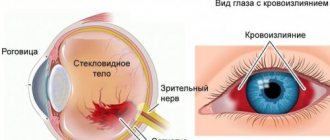Sold exclusively by prescription, Midrimax eye drops have a limited range of uses and are primarily prescribed for diagnostic rather than therapeutic purposes. What this drug is, how it works, what analogues it has, we will consider further.
General information
Brief information about the drug
The first batches of these drops were released in 2012, but this drug cannot be considered fundamentally new. Midrimax drops are based on tropicamide and phenylephrine. These substances dilate the pupil. Separately, they are used as ingredients in solutions for eye therapy. In these drops, these ingredients are combined in such proportions as to enhance the effect of each other, and therefore the drug. Most patients experience severe burning and discomfort after instilling this medicine, but the product gives better results when compared with similar ones.
The main active ingredients of Midrimax are tropicamide and phenylephrine.
Midrimax eye drops - application
To achieve mydriasis during diagnostic and surgical interventions, Midrimax drops are used as follows: drop 1-2 drops of solution into each conjunctival sac 15-30 minutes before the planned manipulations. When treating ophthalmic pathologies, the drug is used in an individual course prescribed by a doctor, one drop up to 6 times a day. The correct algorithm for administering medication into the conjunctival sac is:
- Throw your head back.
- Pull back the lower eyelid with your fingers.
- Instill the required amount of medicine, holding the dropper closer to the outer corner of the eye, without touching the eyelid.
An important instruction for the use of Midrimax eye drops is that after their administration, you should apply light pressure with your fingertips for a couple of minutes on the area of projection of the lacrimal sacs at the inner corners of the eyes. This will somewhat reduce the risk of side effects due to the fact that there will be no significant penetration of the active components of the drug into the general bloodstream.
Midrimax eye drops for children
In the instructions, the manufacturer states that Midrimax drops are not approved for use by children. The ban on the use of the drug in question for children, like many other drugs, is due to the lack of proper clinical studies involving patients in this age group. At the same time, doctors often prescribe this drug to young patients, breaking the law, in order to provide effective assistance in the treatment of various pathologies (often spasm of accommodation). It is important that in most cases the drug is well tolerated and no significant side effects occur.
Midrimaks eye drops - analogues for adults
The drug Midrimax, the use of which is required to achieve an increase in pupil size, copes with its task perfectly thanks to a successful combination of active substances characterized by different mechanisms of action. Previously, each of these compounds was used in ophthalmic practice, but separately or as part of other combinations. Now there are complete analogues of Midrimax containing both tropicamide and phenylephrine, which can replace the drops in question:
- Appamide Plus;
- Fenikamid.
If for some reason the listed drugs are not suitable for use, they are replaced on the recommendation of a doctor with single-component drugs or other medications similar in their principle of action:
- Irifrin (phenylephrine);
- Mezatone (phenylephrine);
- Phenylephrine-Optic (phenylephrine);
- Cycloptic (cyclopentolate hydrochloride);
- Midriacil (tropicamide);
- Unitropic (tropicamide);
- Cyclomed (cyclopentolate hydrochloride);
- Atropine (atropine sulfate).
What does the finished product look like and what does it consist of?
The medication is produced in the form of eye drops. At the same time, it is yellowish or transparent. Main components:
- tropicamide - 8 mg;
- phenylephrine hydrochloride - 50 mg.
Here are examples of other ingredients of Midrimax:
- benzalkonium chloride;
- sodium metabisulfate;
- sodium hydroxide.
What does the drug consist of?
Phenylephrine acts twenty minutes after taking the medicine , the effect lasts up to six hours. Thanks to him:
- the pupil becomes wider;
- blood vessels narrow;
- the outflow of intraocular fluid increases.
Tropicamide paralyzes accommodation and increases local pressure. In addition, it stops the action of M-cholinergic receptors.
Do combinations of active ingredients need to be taken into account?
Midrimax - instructions for use
Midrimax is a solution of eye drops, a mydriatic of the group of m-anticholinergics for topical use. In ophthalmology it is used to provide mydriasis (pupil dilation) during certain diagnostic studies. Prescribed in the treatment of inflammatory processes and adhesions of the eye.
Composition and release form
Midrimax is a solution of eye drops, transparent, brownish-yellow, containing:
- Main components: tropicamide – 8 mg, phenylephedrine hydrochloride – 50 mg;
- Additional substances: disodium edetate, benzalkonium chloride, sodium metabisulfate, hypromellose, sodium hydroxide, hydrogen chloride, water.
Package. Plastic bottles with a dispenser, 5 ml in a cardboard pack.
Pharmacological properties
The effect of the Midrimax solution is due to the properties of the substances included in its composition: phenylephedrine and tropicamide.
Phenylephrine is a non-selective alpha-adrenergic agonist. When applied to the eye, it causes mydriasis (dilation of the pupil), constricts the vessels of the conjunctiva, and improves the outflow of intraocular moisture. Phenylephrine has a stimulating effect on postsynaptic α-adrenergic receptors and has vasoconstrictor properties.
After installation, phenylephrine complements the action of tropicamide, since their mechanisms of action are different. The combination of phenylephrine and tropicamide reduces the ability of the latter to increase IOP.
The effect of the Midrimax solution begins approximately 10 minutes after instillation; pupil dilation remains maximum for an hour and completely disappears after 6 hours.
Indications for use
- Ophthalmological diagnostic tests.
- Preparation for laser treatment.
- Processes of inflammation and adhesions of the eye.
Directions for use and doses
Before carrying out diagnostic or surgical measures, the Midrimax solution is instilled conjunctivally, 1 or 2 drops 15-30 minutes before the procedure.
For medicinal purposes, 1 or 2 drops of the solution are instilled up to 6 times a day.
Contraindications
- Individual hypersensitivity reactions.
- Glaucoma (closed-angle, narrow-angle).
- Serious pathologies of the heart and blood vessels (angina pectoris, coronary sclerosis, arrhythmia, hypertensive crisis).
- Thyrotoxicosis.
- Diabetes mellitus type 1.
- Taking MAO inhibitors (and three weeks after their withdrawal).
- Pregnancy, lactation.
- Age up to 18 years.
Midrimax solution should be administered with caution to elderly patients, people with type 2 diabetes mellitus and cardiovascular diseases.
Side effects
Short-term burning sensation, blurred vision, superficial punctate keratitis, photophobia, accommodation paresis, increased IOP and an attack of glaucoma, manifestations of allergic reactions.
Dry skin, mucous membranes, dry mouth, tachycardia, nausea, vomiting, pallor, agitation, convulsions, headache, respiratory paralysis, coma.
In children, the development of behavioral and psychomotor disturbances, as well as the occurrence of vasomotor and cardiorespiratory collapse, has been reported.
Overdose
If Midrimax solution is accidentally taken orally, tachycardia, mydriasis, dry mucous membranes, agitation, convulsions, respiratory depression, and coma may occur.
As treatment, gastric lavage is prescribed, with the intake of sorbents; As an antidote, physostigmine (slow intravenous), benzodiazepines, and phentolamine are recommended.
Drug interactions
The effect of Midrimax solution is enhanced by sympathomimetics, and m-cholinomimetics are weakened. Tricyclic antidepressants, amantadine, phenothiazines, quinidine, antihistamines, as well as other drugs with m-anticholinergic effects increase the risk of systemic side effects.
special instructions
To reduce the risk of systemic side effects due to the absorption of the solution, after instilling eye drops, it is recommended to apply pressure on the inner corner of the eye for several minutes.
During treatment with Midrimax solution, you must stop wearing contact lenses.
For 6 hours after instillation of the drug, it is unacceptable to drive or work with moving mechanisms.
Store the Midrimax solution at room temperature away from light. Not given to children.
Shelf life – 2 years.
Price of the drug Midrimax
The cost of the drug “Midrimax” in Moscow pharmacies starts from 315 rubles.
Analogues of Midrimax
| Midriacil | Tropicamide | Irifrin | Atropine |
By contacting the Moscow Eye Clinic, you will be able to undergo an examination using the most modern diagnostic equipment, and based on its results, receive individual recommendations from leading specialists on the treatment of identified pathologies.
The clinic is open seven days a week, seven days a week, from 9 a.m. to 9 p.m. You can make an appointment and ask the specialists all your questions by calling 8 and 8 or online using the appropriate form on the website.
specialist of the “Moscow Eye Clinic” Mironova Irina Sergeevna
: November 13, 2015
Source: https://mgkl.ru/patient/aptechka/midrimaks
Impact on the body
Phenylephrine is a non-selective adrenergic agonist. Once in the eye, it dilates the pupil, increases pressure in the conjunctiva, and also increases the outflow of intraocular fluid. It stimulates postsynaptic adrenergic receptors well. This substance is also almost harmless to the heart, although it has a vasoconstrictor effect similar to the effect of norepinephrine. Once in the eye, it contracts the dilator muscle and the smooth muscle of the conjunctival arterioles. The effect appears within ten minutes to an hour, lasting four to six hours. If mydriasis is caused by exposure to phenylephrine, it is not accompanied by paralysis of the ciliary muscle .
Phenylephrine helps dilate the pupil
Tropicamide is an M-anticholinergic blocker. It paralyzes the m-cholinergic receptors of the sphincter of the pupil and the ciliary muscle. This briefly dilates the pupil, blocking the eye's ability to refocus, allowing you to see clearly at different distances. This component causes mydriasis within five to ten minutes, and the effect reaches its greatest peak after 20-45 minutes. The pupil remains maximally dilated for one hour, and after six its width returns to normal.
The action of both components is additive, since they are different in their mechanisms of action. If tropicamide is injected into the eye along with phenylephrine, the second reduces or completely eliminates the effect of the first on the pressure inside the organ of vision.
How do M-anticholinergic drugs work?
Midrimax eye drops - analogues
When prescribing Midrimax for diagnostic or therapeutic purposes, analogues may be required in case of an inadequate response of the body to this drug or in case of its unavailability. The ophthalmologist selects an alternative medication depending on the existing or suspected pathology, age, concomitant diseases, and individual reactions to medications.
Which is better – Midrimax or Irifrin?
In many cases, Irifrin eye drops are used instead of Midrimax. This is a more budget-friendly analogue, which contains only one active ingredient - the alpha-adrenergic agonist phenylephrine hydrochloride. The effect of the drug is to influence one muscle - the dilator of the pupil, due to which it expands. The effect on the ciliary muscle that the second component of Midrimax tropicamide can provide is absent when using Irifrin. In view of this, pupil dilation is not accompanied by paralysis of accommodation (cycloplegia).
Which is better - Midrimax or Tropicamide?
When considering which Midrimax drops have analogs, you should pay attention to the drug Tropicamide. The active ingredient in it is the compound of the same name, which belongs to the group of m-anticholinergic blockers, providing cycloplegic and mydriatic effects. A significant difference from Midrimax is that Tropicamide can cause an increase in intraocular pressure, which is eliminated in the combined drug due to the content of phenylephrine.
Which is better - Midrimax or Fenicamid?
Fenicamid drops are a complete substitute for Midrimax with a similar list of active ingredients in the same concentrations and approximately the same set of auxiliary components. This is a Russian-made medicine, which is more affordable and exhibits the same effectiveness as the drug Midrimax.
What is better – Midrimax or Midriacil?
Midriacil eye drops are a single drug with the active ingredient tropicamide. When assessing which drops are better - the two-component medicine Midrimax or Midriacil, you can turn to one of the studies by Russian doctors, which involved about fifty pediatric patients suffering from myopia. According to the results, Midrimax eye drops showed great effectiveness in the treatment of excess accommodation tension and contributed to the improvement of visual performance.
What is better – Midrimax or Cyclomed?
The ophthalmic drug Cyclomed is a solution, the main component of which is cyclopentolate hydrochloride, an m-anticholinergic blocker. Under its influence, the pupil enlarges due to contraction of the muscle that dilates the pupil and relaxation of the muscle that constricts the pupil. In addition, cycloplegia is caused by relaxation of the ciliary muscle. The list of side effects of Cyclomed includes an increase in intraocular pressure, therefore, if you already have a tendency to this phenomenon, it is preferable to use the eye medicine Midrimax.
Pharmacokinetics
Both main components of Midrimax penetrate into the tissue without any effort. The highest concentration of phenylephrine appears there a quarter of an hour after the product was instilled. Further, less than 1/5 of the substance is excreted from the body by the kidneys, and the rest as inactive metabolites.
The drug begins to act 15 minutes after instillation
Absorption of tropicamide into the blood does not last long. Studies using a modified radioreceptor technique showed that the lower limit of determination of tropicamide in the blood was below 240 ng/ml, and the detection range was equal to 10 ng/ml. The peak concentration of the substance in the blood at the fifth minute was on average 2.8±1.7 ng/ml. An hour after administration, this value changed to 0.46±0.51 ng/ml. And after two it was less than 240 ng/ml.
The drug is quickly absorbed into the blood
In what cases should the drug be used?
This medication is used conjunctivally. Before carrying out diagnostic procedures, one to three drops of the product are instilled into the eye. After ten minutes, you can do an ophthalmoscopy. If it is necessary to perform skiascopy, Midrimax is instilled six times - once every five to ten minutes, then after an hour accommodation is paralyzed. To treat pathologies, drop one or two drops up to six times a day.
It is important to use the medicine correctly
To prevent side effects, when instilling the medicine, it is recommended to press down the lacrimal sacs with your fingers.
How to put eye drops correctly
Video - How to apply eye drops correctly?
Treatment of children - when prescribed and how to use
Although according to the instructions the drug is prohibited for use in pediatrics, however, in practice there are cases when drops were prescribed to children. This usually happens when there is no other method of treatment or diagnosis/operation. Under strict medical supervision, the drug has not yet caused harm to a child - but the drug is not prescribed to children for self-treatment, only in a hospital.
If it is necessary to administer the drug to a child, the dosage is observed - one drop of the drug per day in each eye. Instillation is done at night.
Note that sometimes the use of the drug can cause outbursts of irritability, aggressiveness in a child, and lead to other nervous disorders. However, proper use in the required doses most often does not lead to negative consequences.
When should the drug not be used?
A contraindication for Midrimax is a history of glaucoma: these drops increase local pressure . It should also not be used if you are hypersensitive to the components.
There are contraindications to the use of Midrimax
Other obvious contraindications:
- type 1 diabetes;
- cardiovascular diseases
- thyrotoxicosis;
- age under 18 years;
- bearing a child;
- lactation.
Doctors, when prescribing this medicine, exercise caution if the patient:
- type 2 diabetes;
- age-related risk of heart attack.
Types of diabetes
Side effects
Midrimax has local and systemic side effects. Local :
- reactive miosis - infrequently, and only the next day after use;
- allergy;
- keratitis;
- swelling of the conjunctiva;
- increased intraocular fluid pressure;
- increased production of tears;
- burning and pain in the eyes, and by looking at light sources, a person intensifies these sensations;
- short-term blurred vision.
Possible side effects when using this product
System:
- nausea;
- vomit;
- pale and dry skin;
- dizziness;
- problems with intestinal tone;
- contact dermatitis;
- problems with urination - constant urge or difficulty;
- migraine;
- pulse disturbances;
- tachycardia.
Symptoms of tachycardia
What happens if you take too much medicine?
So far, there have been no documented cases of overdose of this drug when instilled into the eyes. Thanks to the convenient dispenser, it is very difficult to use more than necessary at a time. But taking the drug orally can provoke symptoms of overdose. Therefore, if there are small children at home, the drug should be stored out of their reach. Overdose symptoms:
- increased heart rate;
- dry skin and mucous membranes;
- convulsions;
- long dilated pupil;
- fainting;
- coma;
- Severe poisoning can cause respiratory depression, leading to death.
It is impossible to achieve an overdose of Midrimax if used correctly.
Having discovered symptoms of an overdose, you should immediately take action in relation to the person who received them:
- rinse the stomach;
- take sorbents, for example, activated carbon;
- consult a doctor.
Activated carbon
In addition, depending on the case, it may be important to provide symptomatic therapy.
Interaction
Using Midrimax together with adrenergic blockers, it is possible to enhance the local pressure-increasing effect achieved by phenylephrine, since vasodilation will be suppressed. Due to the phenylephrine content, it is better not to use this drug in combination with guanethidine or any other adrenergic blocker, as well as a monoamine reuptake inhibitor. This combination increases the likelihood of a hypertensive crisis.
If Midrimax is used together with monoamine oxidase inhibitors or earlier than 21 days after the combination has been discontinued, the likelihood of systemic adrenergic effects increases.
It is important to correctly combine Midrimax with various means
By using Midrimax with tricyclic antidepressants, methyldopa, and m-anticholinergic blockers, its vasopressor effect can be enhanced. If you first introduce local anesthetics by drop, you can enhance its absorption into the mucous membranes and also prolong the dilation of the pupil.
How do drops combine with other drugs?
Use in pediatrics
Of course, the instructions prohibit the use of Midrimax in the treatment of the younger generation, but it also happens that other means are not suitable for therapy or diagnosis. When using the drug under the supervision of doctors, it can be used in pediatrics , since here and under this condition it has not yet harmed anyone. However, this is only permissible in a hospital setting. If Midrimax has to be administered to a child, the dosage is always carefully observed: a drop per day in one eye and in the other. Sometimes this medicine causes irritation, the child may have a temper tantrum, or other nervous problems. But if you use the drug correctly, strictly following the dosage, this rarely happens.
"Midrimax" for children can only be used under medical supervision
What treatment methods are used for the disease?
Astigmatism in the early stages has virtually no symptoms: visual acuity gradually decreases, but such minor changes are invisible to the patient. However, it is at this stage that conservative treatment can give a good result.
Drug treatment is advisable if visual acuity has decreased by no more than 1 diopter.
In the future, the doctor prescribes more radical methods:
- Spectacle correction. Glasses are selected individually, taking into account the location of the optical axes, and they look a little different than standard glasses for vision correction, because they are equipped with cylinders. Sometimes glasses with toric lenses are recommended.
- Hard contact lenses. Hard lenses for astigmatism are worn only at night. They are gas-tight and are able to gradually change the shape of the cornea, bringing it closer to normal.
- Microsurgical intervention. For astigmatism, a number of operations are performed: astigmatic keratotomy, photorefractive keratectomy, thermokeratocoagulation, lens replacement, and the introduction of intraocular permanent lenses.
- Laser keratoplasty. In this operation, the shape of the cornea or lens is aligned with laser beams. Laser manipulation allows you to completely restore vision without further deterioration, but such procedures are very expensive.
Before deciding on such drastic correction methods, the doctor must conduct a thorough diagnosis and determine whether the possible therapeutic effect outweighs the existing risks and complications.
Folk remedies, special eye exercises, and some physical therapy methods are used as additional treatment methods.
The role of drops in therapy
Eye drops in therapy are very important. They are prescribed to consolidate the therapeutic effect after surgical interventions and other types of correction, and also to prevent vision from deteriorating.
IMPORTANT! Drops help maintain the degree of astigmatism in a stable state.
Functions of eye drops for illness:
- improve metabolic processes and blood circulation in the structures of the eye;
- supply the cornea, lens and eye tissues with minerals and nutrients;
- launch and accelerate the process of tissue regeneration;
- relieve tension, fatigue, irritation;
- eliminate dry eyes, moisturize the surface;
- protect from negative external factors.
If you start using drops at the initial stage of the disease, you can avoid its progression, stop the deterioration of vision, and also avoid surgical intervention in the future.
Similar medicines
When treating eye diseases, the pupil can be dilated not only with Midrimax, but also with its analogues.
| Name | Description |
| "Cyclomed" | This is an M-anticholinergic blocker. It acts on the ciliary muscle and the antagonist muscle. This causes the pupil to completely relax, while dilating. The action begins before twenty minus passes after using these drops. It lasts for at least eight hours. The residual effect can last up to 24 hours. |
| "Mydriacyl" | The main component is exposed to the iris and ciliary muscle. This dilates the pupil and also paralyzes the ciliary muscle. This remedy has few side effects, and the pupil remains dilated for a short time. Pressure increases less than with analogues on atropine. The onset of action occurs ten minutes after instillation, the effect lasts five to six hours. |
| Atropine sulfate | This drug is produced on an atropine basis. It blocks M- and N-cholinergic receptors. The action begins very quickly after instillation. The drug is potent, so the pupil always dilates. But a “side effect” is also inevitable - a deterioration in the secretion of most of the other glands throughout the body. |
| "Tropicamide" | Blocks m-cholinergic receptors of the ciliary muscle. The effect begins to appear immediately after instillation, but also passes quickly. It lasts no more than sixty minutes, and over the next five hours the pupil size manages to return to normal. |
Let's take a closer look at the Mydriacyl product.
"Mydriacyl"
Eye drops for astigmatism and their role in treating the disease
Eye drops for astigmatism and their role in the treatment of the disease.
Source: beregizrenie.ru Eye drops for astigmatism are not able to restore vision, since its radical correction is possible only with the help of glasses or lenses. Medicines will help relieve fatigue after a hard day, remove irritation of the mucous membrane and prevent the conjunctiva from drying out.
The last point is very important for people whose professional activities are closely related to computers. In addition, correctly selected eye drops for astigmatism will help normalize intraocular blood circulation.
Medicines stimulate metabolic processes, as a result of which the optic nerve and other structures are enriched with a variety of nutrients and vitamins.
They easily eliminate the feeling of fatigue, dryness, and relieve tension. Effectively protect against adverse environmental factors that can affect the organ of vision.
Since the main cause of astigmatism is changes in the cornea and lens, the action of eye drops is aimed at improving their functions. This will help restore visual function, although it will not provide a complete recovery.
Additional Helpful Tips
A large contraction of the pupil dilator soon after use (after half an hour to 45 minutes) often causes pigment particles from the iris to appear in the aqueous humor of the anterior chamber of the eye. This suspension should not be mistaken for symptoms of anterior uveitis. You also don't have to worry about blood particles getting in there.
Contact lenses can absorb preservatives from Midrimax. Wearing them may cause irritation. So before using the drops you need to remove your lenses. You can put them on again no earlier than a quarter of an hour after using the product.
Before using Midrimax, you need to remove your lenses.
To reduce the likelihood of systemic side effects, when instilling it, it is best to lightly press your finger on the area where the lacrimal sacs are projected for a minute or two.
How to remove a lens
What drops are needed?
What drops are needed?
Source: glazexpert.ru Much depends on the cause of the vision defect (congenital, acquired). So, if astigmatism was caused by keratoconjunctivitis, antibacterial, analgesic, and moisturizing drops are needed. When astigmatism is hereditary, preventive measures can be used. To prevent the development of astigmatism:
- viziomax;
- optocline;
- tauphone;
- tocopherol;
- riboflavin;
- tocopherol
These are drops based on vitamins beneficial for the eyes.
Moisturizers include:
- Systain;
- optiv;
- oxyal;
- Visine;
- stillavite;
- ketotifen.
These drops contain chemicals that help lubricate the tears. They are ideal for astigmatic contact lens wearers.
Anti-inflammatory drugs include:
- Visine;
- tetrizoline;
- naphazoline;
- nafcon;
- fenir.
The active ingredients of these drugs relieve burning and redness. They are the best way to combat the symptoms of eye fatigue that often appear with astigmatism.
Antibacterial:
- tobrex;
- iodurol;
- Quinax;
- Vitafacol.
The active ingredients of these drops fight bacteria that cause inflammatory eye diseases.
An ophthalmologist should select the drops, since self-medication can worsen vision.
Eye drops for astigmatism are an auxiliary means of vision correction. They are recommended to be combined with conservative treatment methods, such as wearing glasses or contact lenses.
You should know that they are not able to change the shape of the cornea and lens, but they can prevent the development of astigmatism and eliminate the unpleasant sensations in the eyes that arise from constant strain.
How and for how long to store?
When storing the product, maintain a temperature of 25 degrees Celsius. You cannot keep it in the refrigerator: cold destroys the main components of the drug and forms sediment in it.
It is important to store the drug correctly
Important! If you do not open the bottle, it can be stored for two years. Once opened, you must either use it all within 28 days, or then throw away the rest.









